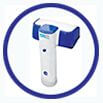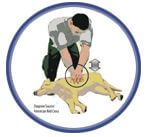FREE Standard Shipping On All Orders $100 or More!*
Pool Pet Safety - Safer Pools for Animals
It is very important for pool owners to have safety in mind not only for humans but also for their pets and other wild life that could potentially drown in your swimming pool. Thousands of family pets drown in a swimming pool each season, and no one wants that to happen. Here's some ideas for pet pool safety that will prevent you from having to go through such a tragedy.
PETS AT HIGH RISK
The pets that have the highest risk from pool drowning are those older, blinder, less athletic dogs and cats. Most dogs and cats can swim for a short distance but when panic kicks in this leads to exhaustion. Dogs and cats have the highest risk of drowning but any household pet that walks has the potential of drowning in your backyard swimming pool.
Visiting pets, neighbor pets or strays that are able to wander into your backyard, are at high risk, because they may not be accustomed to swimming, and may have trouble finding the exit steps. New pets in the house should be trained to exit the pool, even if you do not normally allow them to swim, or if they do not like to swim. Train your dog and visiting dogs to the pool, (takes just 5 minutes) on where and how to exit the pool.
WILD ANIMALS FOUND IN POOLS
One of the most common wild animals that are found in swimming pools is deer. They get spooked and run right into the pool. Other animals that are found in swimming pools are birds, rabbits, skunks, squirrels, racoons, mice, frogs and even snakes. :-0

Depending on your geographic location in the US, you could have anything from alligators to moose, prairie dogs and armadillo. Many animals may come to drink, and bears are known for taking a dip for the purpose of cooling off. Keeping a well maintained pool fence is one of the best layers of animal and pet pool safety.

POOL PET SAFETY PRODUCTS

POOL ALARM: it is important to have layers of protection for your swimming pool for pets, animals and humans. The number one safety device every pet owner should have is a pool alarm. If any object 17 lbs or greater enters the water a very loud alarm goes off that can be heard around the entire house. This works similar to a baby monitor where you have a remote receiver inside the house. As long as your pet weighs over 15 lbs, a pool alarm will sound the alarm if your pet falls in the pool.

SAFETY TURTLE: A specific pool safety alarm that is used with pets is the Safety Turtle alarm with base. The way this works is you have a turtle type collar that secures to your pets neck on the collar and if the turtle gets submerged in water it sounds off a very loud alarm on the turtle base station. The turtle alarm will not shut off until you physically reset the alarm. There is never any reason to shut off this alarm so your pet is protected at all times. With a standard pool alarm every time you clean the pool or when you are using it you have to shut off the alarm.

FENCES: I do strongly recommend any pet owner that owns a pool to make sure the pool itself is fenced in separately, within the backyard. You can use a permanent fence; aluminum, mesh, wood or vinyl to secure your swimming pool, or we do offer a removable mesh pool safety fence that is easy to install and also very simple to remove when needed. Some sort of barriers between the pool and animals will go a long way to making your pool safer, even if it's not a complete surround type of pool fence.

RAMPS: For pools without wedding cake type, in-pool step, a beneficial product for your pet or any wild animal would be the Pet Step. It provides an easy way for your pet or wild animal to climb up the ramp or stairs so they can exit the pool. Pools without steps or swim outs are impossible for animals to get out. They swim around the pool until they tire out, panic and drown. The Pet Step is also easily used by small critters of the woods that fall in the pool and have no way to exit, from small to large animals.

SAFETY COVER: Finally, the last safety product every pet owner should have especially if your pool is not fenced in separately is a safety cover. Pool safety covers are available in both mesh or solid material. When my dog Molly gets into the pool area, my yard is fenced in separately but if she gets into the pool area she can walk across my pool safety cover and I do not have to worry about her falling into my pool and drowning. I could not picture my kids' faces if my dog drowned in my swimming pool - you can never put a price on safety.

DOG LIFE VESTS: For dog owners that are looking for a cheaper or temporary solution, there are Dog Life Jackets. If your pet falls into the pool, the life jacket will prevent your dog from tiring easily. Also a great way for a dog to get some water exercise, without worry for your pet, although proper supervision is still required.
Pet CPR

If you are too late and see your dog struggling, or even laying motionless, your pet may be in dire need of CPR. it is important to know that CPR on dogs can cause ribs to bruise or break and thus should only be performed under necessary conditions (no practicing).
First make sure your dog is responsive by talking to it. Talk and rub the dog to see if there is any response. If there is none, the dog may be unconscious, or may have passed. Check for a pulse; if there is no pulse and no response, begin CPR.
CPR: Lay the dog on a flat surface with one side against the surface and one side facing up. Cup your palms together over the chest with one palm on either side above the heart area. Compress the chest for one inch, or about one-quarter of the width of the chest for a count of one and then let go for a count of one. Carry on at a 100 compression-per minute rate.
Artificial Respiration: Breathe into the dogs nose once every five compressions. Watch for the chest to rise and wait 2 seconds to allow the air to exhale, before resuming chest compressions. Continue with CPR and artificial respiration until the dog starts to breathe on its own again or until several minutes have passed with no response.
So, give some thought to pet pool safety, and make your pool safer for those furry members of your family and community and for the wild animals of the woods that could end up in your pool.